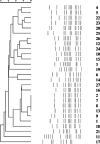Fluconazole exposure rather than clonal spreading is correlated with the emergence of Candida glabrata with cross-resistance to triazole antifungal agents
- PMID: 22632885
- PMCID: PMC11916436
- DOI: 10.1016/j.kjms.2011.11.011
Fluconazole exposure rather than clonal spreading is correlated with the emergence of Candida glabrata with cross-resistance to triazole antifungal agents
Abstract
The emergence of antifungal resistance in Candida species has raised concern in recent years, especially resistance toward triazole. Several newer triazole antifungal agents have been introduced which have a broader spectrum for fungal infections, such as voriconazole. However, cross-resistance among triazoles is a major concern with regard to their clinical application. Antifungal susceptibility was performed using E-test for 166 clinical isolates (29 blood and 137 nonblood isolates) in 2003 and 2004. We applied pulsed-field gel electrophoresis for genotyping. Ninety isolates of C. albicans, 47 isolates of C. tropicalis, 27 isolates of C. glabrata, and two isolates of C. krusei were included. All isolates were susceptible to amphotericin B. Eleven (40.7%) of the 27 C. glabrata had intermediate resistance to caspofungin. Forty-seven (28.3%) of the 166 isolates were not susceptible to fluconazole, including two C. albicans, 16 C. tropicalis, 27 C. glabrata, and two C. krusei isolates. All except seven of the C. glabrata isolates were susceptible to voriconazole. All the triazole drugs had a positive correlation among their minimum inhibitory concentrations (MICs). Fluconazole MIC was a good predictor for susceptibility to voriconazole, as determined using a receiver operating characteristic curve. Furthermore, a high diversity of pulsotypes for the 27 clinical isolates of C. glabrata was observed. Previous fluconazole exposure within 3 months was associated with reduced triazole susceptibility for C. glabrata. We demonstrated a significant positive correlation of MIC values among the four tested triazole drugs. No amphotericin B and caspofungin resistant isolates were found in this study. The cross-resistance to triazole among C. glabrata isolates was associated with previous fluconazole exposure as opposed to clonal spreading. Selection pressure due to fluconazole use may play a major role in triazole cross-resistance.
Copyright © 2012. Published by Elsevier B.V.
Figures



Similar articles
-
The activity of echinocandins, amphotericin B and voriconazole against fluconazole-susceptible and fluconazole-resistant Brazilian Candida glabrata isolates.Mem Inst Oswaldo Cruz. 2012 May;107(3):433-6. doi: 10.1590/s0074-02762012000300022. Mem Inst Oswaldo Cruz. 2012. PMID: 22510843
-
Trends in species distribution and susceptibility of bloodstream isolates of Candida collected in Monterrey, Mexico, to seven antifungal agents: results of a 3-year (2004 to 2007) surveillance study.J Clin Microbiol. 2008 Sep;46(9):2902-5. doi: 10.1128/JCM.00937-08. Epub 2008 Jul 16. J Clin Microbiol. 2008. PMID: 18632907 Free PMC article.
-
[Antifungal susceptibility profiles of Candida species to triazole: application of new CLSI species-specific clinical breakpoints and epidemiological cutoff values for characterization of antifungal resistance].Mikrobiyol Bul. 2016 Jan;50(1):122-32. doi: 10.5578/mb.10682. Mikrobiyol Bul. 2016. PMID: 27058336 Turkish.
-
Candida and candidaemia. Susceptibility and epidemiology.Dan Med J. 2013 Nov;60(11):B4698. Dan Med J. 2013. PMID: 24192246 Review.
-
In vitro antifungal activities of voriconazole and reference agents as determined by NCCLS methods: review of the literature.Mycopathologia. 2001;150(3):101-15. doi: 10.1023/a:1010954803886. Mycopathologia. 2001. PMID: 11469757 Review.
Cited by
-
Synergistic Effect of Fluconazole and Calcium Channel Blockers against Resistant Candida albicans.PLoS One. 2016 Mar 17;11(3):e0150859. doi: 10.1371/journal.pone.0150859. eCollection 2016. PLoS One. 2016. PMID: 26986478 Free PMC article.
-
Nosocomial candidiasis in Rio de Janeiro State: Distribution and fluconazole susceptibility profile.Braz J Microbiol. 2015 Jun 1;46(2):477-84. doi: 10.1590/S1517-838246220120023. eCollection 2015 Jun. Braz J Microbiol. 2015. PMID: 26273262 Free PMC article.
-
Epidemiology, species distribution and outcome of nosocomial Candida spp. bloodstream infection in Shanghai.BMC Infect Dis. 2014 May 6;14:241. doi: 10.1186/1471-2334-14-241. BMC Infect Dis. 2014. PMID: 24886130 Free PMC article.
-
Surveillance of the prevalence, antibiotic susceptibility, and genotypic characterization of invasive candidiasis in a teaching hospital in China between 2006 to 2011.BMC Infect Dis. 2013 Jul 30;13:353. doi: 10.1186/1471-2334-13-353. BMC Infect Dis. 2013. PMID: 23899244 Free PMC article.
-
The lung mycobiome: an emerging field of the human respiratory microbiome.Front Microbiol. 2015 Feb 13;6:89. doi: 10.3389/fmicb.2015.00089. eCollection 2015. Front Microbiol. 2015. PMID: 25762987 Free PMC article.
References
-
- Chen Y.C., Chang S.C., Sun C.C., Yang L.S., Hsieh W.C., Luh K.T.. Secular trends in the epidemiology of noscomial fungal infections at a teaching hospital in Taiwan, 1981 to 1993. Infect Control Hosp Epidemiol. 1997; 18: 369–375. - PubMed
-
- Ruan S.Y., Hsueh P.R.. Invasive candidiasis: an overview from Taiwan. J Formos Med Assoc. 2009; 108: 443–451. - PubMed
-
- Centers for Disease Control, R.O.C. (Taiwan) . Statistics of Communicable Diseases and Surveillance Report. R.O.C. (Taiwan): Taipei City: Centers for Disease Control. 2008, 40–44.
-
- Yang Y.L., Wang A.H., Wang C.W., Cheng W.T., Li S.Y., Lo H.J., et al. Susceptibilities to amphotericin B and fluconazole of Candida species in Taiwan surveillance of antimicrobial resistance of yeasts 2006. Diag Microbiol Infect Dis. 2008; 61: 175–180. - PubMed
-
- Hsueh P.R., Lau Y.J., Chuang Y.C., Wan J.H., Huang W.K., Shyr J.M., et al. Antifungal susceptibilities of clinical isolates of Candida species, Cryptococcus neoformans, and Aspergillus species from Taiwan: surveillance of multicenter antimicrobial resistance in Taiwan program data from 2003. Antimicrob Agents Chemother. 2005; 49: 512–517. - PMC - PubMed
Publication types
MeSH terms
Substances
LinkOut - more resources
Full Text Sources

